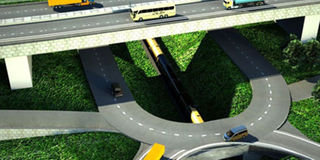Prime
Jinja expressway will spur regional integration - Unra

An artistic impression of Kampala-Jinja Expressway at Kinawataka, Kampala.
What you need to know:
- The expressway will support regional integration by connecting the landlocked Uganda and other inland countries such as Burundi and the eastern DR Congo to Mombasa.
1,500 Job market: A combination of phases 1 and 2 of the project is expected to generate up to 1,500 jobs.
BY PHILIP WAFULA
Despite the government securing funds in excess of Shs800 billion meant for the construction of the $1.48b (about Shs5.3 trillion) Kampala-Jinja Expressway (KJE), works will commence next year, the Uganda National Roads Authority (Unra), the implementing partner, has said.
This comes after the recent signing of a financing agreement for Phase 1 between African Development Bank (AfDB) and the Ugandan government worth $229.5m (about Shs828 billion).
This, however, was not the first funding secured. A total of €90m (about Shs369 billion) was already got from the European Union as grant, an additional funding of $90m (about Shs324 billion) is expected from the French Development Agency, while the balance will be provided by the private sector.
“Construction shall commence when all the funding is secured; that is to say from the government and private sector, and that is expected to be in 2022,” Mr Allan Ssempebwa, the Unra spokesperson, said at the weekend.
He added that the construction period is five years from commencement. The work was expected to start in 2015, with commissioning planned for 2020. The initial project preparation commenced with a feasibility study in 2010 before it hit a snag.
The project will be the fourth route connecting Kampala to Jinja, besides the current highway, the Gayaza-Kalagi-Bukoloto-Njeru Road and the Mukono-Kyetume-Kisoga-Nkokonjeru-Nyenga Road and forms part of the Northern trade corridor from Mombasa in Kenya through Kigali in Rwanda.
It is also a strategic corridor which serves as a trade link to the sea for landlocked countries of Uganda, Rwanda, Burundi, South Sudan as well as the eastern DR Congo.
The project will be the first of its kind in the country using a public-private partnership (PPP) model, implying that the contractor will design, build and operate the route for 30 years, earning profits by charging tolls before transferring the ownership to the state.
Commenting on how far Unra has reached with procurement of the contractor for the project, Mr Ssempebwa said the process is at Request for Proposal Stage.
“Bidders were already prequalified and will be invited to submit technical and financial proposals. What is, however, pending is that Unra is awaiting the government approvals before proceeding to invite proposals which will be followed by selection of the preferred bidder,” Mr Ssempebwa said.
The Kampala-Jinja highway still has heavy traffic jam despite other alternative routes which serve the same objective.
However, the KJE belongs to the northern corridor, a major gateway for imports and exports and is intended to relieve traffic congestion, improve road safety, and spur economic growth in the region.
As such, it will support regional integration between the Port of Mombasa in Kenya and the landlocked countries of Uganda, Rwanda, Burundi and the DR Congo.
A combination of phases 1 and 2 of the project is expected to generate up to 1,500 jobs and 250 jobs during operations, most of which are expected to be filled by Ugandans.
Once operational, the KJE is expected to reduce travel time between Kampala and Jinja by approximately 70 minutes and also support the government revenue through toll road fees and taxes.
Impact
The project will, however, have adverse environmental and social impacts. Displacement will, for example, pose a substantial risk because the project necessitates relocation and resettlement of households, businesses, schools, and health centres.
Mr Ssempebwa has described resettlement and compensation as ‘a more critical stage of the project’, which is currently being worked on so that the project doesn’t leave anyone worse off.
“We are acquiring the Right Of Way (ROW) because what used to happen before was that we would acquire the ROW when the contractor is on the ground and that would increase on the cost of construction as the contractor would put in extra claims for idle time,” Mr Ssempebwa said.
“Under the new reforms in the land acquisition exercise, we now acquire ROW before the contractor comes on sight to avoid unnecessary financial claims; and that’s what we are doing with the KJE,” he added.
On average, between 750 and 1,000 trucks go through the Busia border, while between 1,000 and 1,500 use the Malaba border.
Transporters speak out
Transporters at the Busia border, who have endured spending long hours on traffic jam due to the narrow road, say the project comes with huge benefits.
Mr Ronald Kizito, a transporter at the Busia border, is optimistic the construction of the KJE will reduce congestion, citing Lugazi in Buikwe District and Kampala as a big problem.
“We spend three hours on traffic jam between Lugazi and Kampala which is usually a 30-minute drive,” Mr Kizito said, adding that the transport costs will reduce.
He recounts several hours he spent on the road in Mabira Forest when a truck overturned and blocked the narrow stretch of the road, causing a traffic gridlock.
Ms Kizito adds that it is important the contractors undertake construction of a quality road relating to the funds. He say the project work is long overdue.
Mr Muhamad Teefe, another transporter at the border, said there have been accidents and delays to deliver goods from Busia to Kampala.
“As transporters, sometimes we carry perishable consignments and any delays affect business. We feel this is a good project by the government,” he said.
According to Mr Teefe, it would have even been better to have the stretch of the project extended up to the Busia border.
Additional reporting by David Awori




